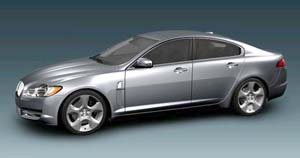
I hope this doesn’t mean that Jaguar has gone back to its old ways as a US survey puts the Toyota Prius at the top of its reliability list, and the Jaguar XF (left) at the bottom. Both cars have been nominees in Lucire’s Car to Be Seen in awards: the Toyota in 2004–5, the Jaguar in 2007–8.
The TrueDelta.com reliability survey claims to have 36,000 cars in its database, with owners surveyed throughout the year. This gives it, says the company, more accuracy than the Consumer Reports surveys which are done on an annual basis, where respondents tend to remember only the latest problems.
The 2008 Prius averaged five dealer trips per 100 vehicles, while the 2009 XF averaged 159 per 100 vehicles. The average is 60.
Nine out of twenty-six XF owners needed repairs to their car by the end of the year (October 1, 2007–September 30, 2008), compared to two out of seventy-four for the Prius.
La Milonga: romance and tango at Miami Short Film Festival
New technologies from BMW at LA Auto Show









true delta is a waste of time, how you can justify ranking a car last with only 26 respondants is pathetic, especially when they have sold many thousands of the car since March, i am the owner of an XF and am a member of a forum of XF owners and the true delta guy comes on there and bullies the people into going to his site and putting results but when people have no results as they have a car that worls perfectly they DO NOT GET INVITED TO PUT INFO IN, and i know this for a fact as we were not invited to put our info into the system when we had no issues as i know a couple of others that have had no problems have also not been invited after they had registered..
Strange that isn’t it…!!!!
Very interesting, Jon—good to get some inside knowledge of this possible bias. I agree 26 sounds a bit low, especially out of 36,000 of all cars—especially in the US where there just aren’t as many models on sale. I wonder how Consumer Reports compares.
Thanks for covering this, Jack.
As I’ve stated in response to Jon’s rants elsewhere, I’m not sure where he gets the idea that I don’t send the surveys to people who don’t report repairs. I suspect he’s misunderstanding how the process works. But since he’d rather leap to conclusions than get to the bottom of this, it’s not possible to find out. And bullying people? Please. It’s quite a stretch to see “50 owners signed up so far, more would be helpful” as bullying.
What we have here is someone who doesn’t like the result. This tends to happen whenever a model has a high repair rate. Sorry, but every car can’t be above average in reliability. I personally don’t care how any particular model ends up–I just report what the data dictate.
I would like to correct some possible misinterpretations. There are over 36,000 cars signed up to participate in the survey, but I don’t include a model in the main survey until at least 25 owners are signed up. So all of those cars aren’t active in the survey.
Unlike other surveys, I do post the number of responses for each model.
A larger sample size is always better, but I have found that the results get reasonably accurate with only about 25 responses. Now, with a result of 159 the actual number might be 20-30 in either direction. But 130 would still be high.
I don’t actually post the number of cars that have required repairs, because this can be misleading. I do post the average number of months of data per car. Because the results are annualized, if we have an average of four months of data per car then each reported repairs essentially counts as three repairs. Based on the data so far, it’s generally a valid assumption that, say, ten reported repairs in four months will translate to 30 over the course of a year. Some cars go up, some come down, most stay level.
The XF, though, has been coming down. Three months ago the repair rate was 220 per 100 cars. If this trend continues, it might have a repair rate around 100 in future results.
If a model has gotten much worse or much better than in earlier results, I note this in a comment.
In contrast, the 2007 Chrysler minivans have been around 150 for the last three sets of results. If I had to predict whether these minivans or the XF would have the highest repair rate a year from now, I’d go with the minivans.
Finally, note that the survey only includes about a quarter of the 2008s, and a handful of 2009s. So while the XF had the highest repair rate of the 2008s and 2009s, it might very well not be the highest if every model were included in the survey.
The #1 limitation of this survey is definitely the size of the sample. So I truly do appreciate your help getting the word out.
Michael, thank you for offering your side of the story so we can get a fuller picture and for pointing out the potential statistical accuracies with even 25 responses. Out of academic curiosity, may I ask which was the most popular model for your survey?